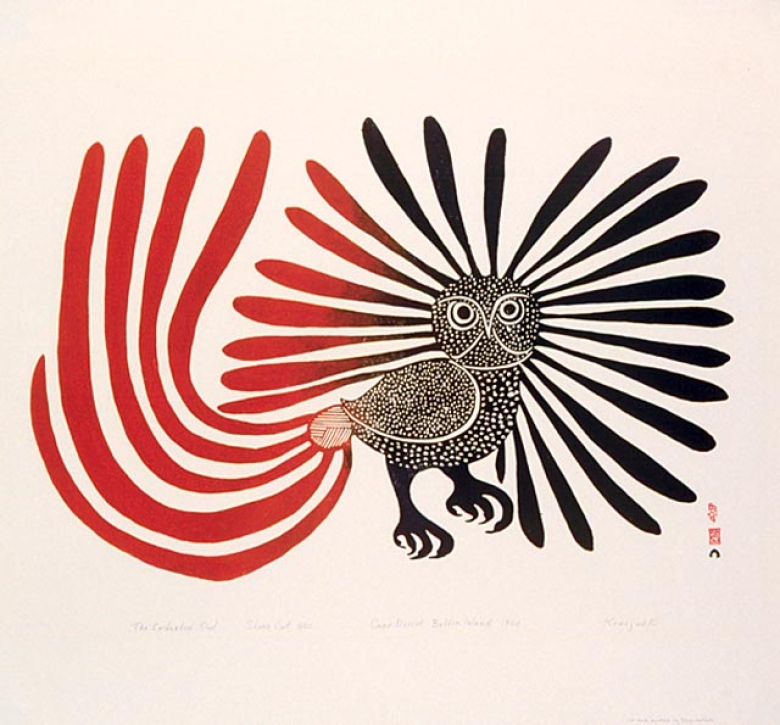Should northern artists get a cut on resold art? This Inuk artist says yes
The Enchanted Owl print sold at an auction for $216K, but artists estate wont see any of that money

A major purchase of Inuit art has left some asking whether artists are getting a fair cut from the work they create.
The now-iconic print, The Enchanted Owl, was created by famed Nunavut artist KenojuakAshevak in 1960 and was first sold for about $50. On Nov. 20, one of the limited-edition prints sold for $216,000 at Waddington's, a Toronto auction house.
But because Ashevak, who died in 2013, had already sold the piece, her estate did not get any of that money sparking questions from artists about what they should get when their work is resold.
Kablusiak, who also goes by Jade Nasogaluak Carpenter, is an emerging Inuvialuk artist and sculptor based in Calgary who makes soapstone carvings of items like cigarettes or sex toys. Kablusiak, who uses the prounounsthey or them,was excited to hear about the purchase at first.
But after more thought, Kablusiaktold CBCthey found it "disgusting."
"I am glad Inuit art is placed so highly, but it is terrible that the artist [and] their families are left in the dust," Kablusiakaddedin a text message.

Canadian Artists' Representation, alobby group, has been advocating for years for artists or their estates to get a small cut when artwork is resold also termed the artist resale fee.
This year, the federalstanding committee on industry, science and technology is taking a mandatory review of Canada's Copyright Act. Canadian Artists' Representation is asking the committee to consider making it mandatory for sellers and dealers, such as galleries or auction houses, to give a portion of the resale to the artist or artist's estate like afive per cent total resale fee.
Janet Brewster, the executive director of the Nunavut Arts and Crafts Association, said a resale fee would have a direct benefit in her northern community of Iqaluit.
"Inuit artists are very prolific, and there are a lot of subsistence artists who basically make art every day in order to feed their families," Brewster said.
Royalties for art resale would allow artists to take care of their families, even when they are no longer alive, said Brewster.
"If somebody passes away, then they're leaving a legacy behind."
Brewster added that musicians have received royalties for their work for a long time, and that in places like the United Kingdom, an artist resale fee has become the norm.
According to Canadian Artists' Representation, 93countries have mandatory resale fees for artists.

Canadian Artists' Representationspoke at the standing committee on industry, science and technology in October.
One of the group's board members, Joshua Vettivelu, a Toronto-based artist who also uses the pronoun they, said that resale rights for artists would have the biggest benefit on creators in the North who often create work to support their families.
"Indigenous artists, specifically those in the North, suffer from a lack of access to the primary market. And if they do have access, it is often exploitative," said Vettivelu, according to the meeting notes.
"The structural conditions of colonialism, which are very real, often force Indigenous artists to sell their work for lower price points to make ends meet and to provide for their families and communities."
Vettivelusaid they hope the secondary art market, where collectors turn around their pieces for a higher price point, would be less exploitative if artists got a small percentage.
'A terrible idea,' says group
But a group representing Canadian art dealers was not so supportive.
Spokesperson Mark London said the administrative process to make sure small fees will get into artists' hands would be onerous hampering galleries without helping burgeoning artists.
London, who owns Galerie Elca London in Montreal which specializes in Inuit art, represented the Art Dealers Association of Canada to the committee in October. London said an artist's resale right would be complicated, and that "sales would tumble" under resulting higher prices.
He also said that in purchasing Inuit art, he buys from the West Baffin Eskimo Co-operative, then sells the piece to a collector meaning the art has exchanged hands several times evenbefore the first retail sale.
He said that the repeated artist fees would raise prices of art-making and patrons are less likely to buy it.
"We think [it's] a terrible idea," London said, according to the parliamentary record of the meeting.
Kablusiak said a small resale fee for artists, like five per cent,is a start,but it will take more changes to the industry to make it less exploitative of young artists.
Kablusiak's art hasn't been resold for large sums yet, but the artist is confident that it will happen.
"It's only a matter of time," Kablusiak said.
But Kablusiak wonders when that happens, whether they will get any of the fruits from their success.
- MORE NORTH NEWS |Moose rings Alaska home's doorbell, plays 'ding dong ditch'
- MORE NORTH NEWS |TIFF recognizes Haida film released by Nunavut production company
With files from Loren McGinnis












_(720p).jpg)


 OFFICIAL HD MUSIC VIDEO.jpg)
.jpg)



























































































